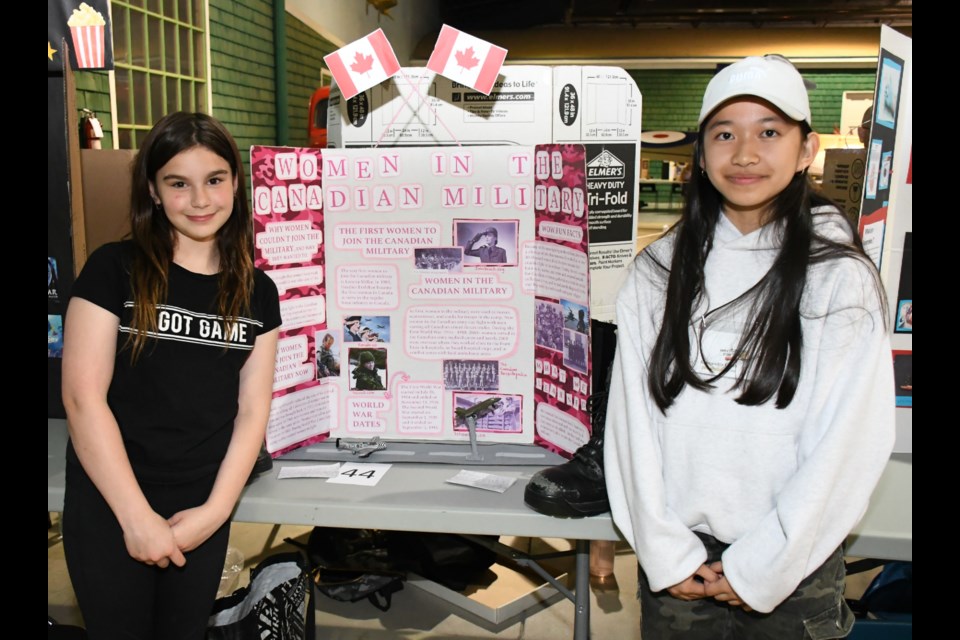From syrup and the Underground Railroad to hockey and immigration, area elementary students dug deep to investigate many different historical topics this year for their Heritage Fair projects.
The Western Development Museum (WDM) hosted the regional Heritage Fair on May 8, with 81 students from in and around Moose Jaw producing 60 projects using cardboard posters and props to accompany their presentations.
When they weren’t discussing their projects with judges, students participated in workshops with the Saskatchewan Science Centre and WDM, searched the museum for objects, and toured the Sukanen Ship Pioneer Village and Museum.
Once all the judges’ scores had been tallied, Heritage Saskatchewan — which organizes the regional and provincial Heritage Fairs — recognized the top 20 projects. The top three will attend provincials on Wednesday, June 5, in Regina.
Important footwear
Emily Harnett and Yuanjun Lu from William Grayson School focused on Inuit footwear, known as mukluks.
They explained that the soft, waterproof boots played an important role in Canadian history since they kept their wearers’ feet warm and allowed northerners to do almost anything — from hunting to travelling — in freezing temperatures.
Inuit normally made the boots from either seal skin or reindeer skin, while they could be worn over an inner boot liner or under a protective overshoe.
Harnett and Lu discovered that the Inuit used bone beads to decorate the footwear but later switched to glass beads — acquired from European explorers — because they didn’t dig into the boot as much.
“And way back (then), the bead pattern (was) special and different for everyone … and now, the bead patterns are the same thing (for everyone),” said Lu.
“So now they don’t have meaning,” added Harnett. “But the ones back then had a lot of meaning.”
Women’s contributions
Caleigh Craig and Kassandra Gutib from Gravelbourg focused on women in the military and how their roles have evolved in Canada since the First World War.
“I think (this topic is) really important because (the) military is a really big part of Canada and women are a big part of Canada and they should have more credit for what they did in World War I and II,” Craig said.
For example, the students noted that, during the First World War, women served as nurses and made clothing for men, while during the Second World War, women joined military units as non-combatants and worked in factories.
Through their research, Craig and Gutib discovered that Loretta Miller was the first woman to serve in the Canadian military — she joined as a nurse during the 1885 North West Rebellion — while Heather Erxleben was the first female to serve in the regular infantry force, joining in 1989.
One interesting thing the students learned is just how “misunderstood” women have been.
“All men thought they could do was cook and clean and take care of the kids. I can’t imagine doing that … ,” said Craig, adding while she would be OK with supporting men, she wanted them to treat her with respect.
A judge’s view
Kristin Enns-Kavanagh was one of dozens of volunteer judges who visited with students and asked them questions to determine how well they knew their material. She has judged for several years — she has a heritage-focused career — and enjoys interacting with students.
“They’ve been amazing; they always are. The kids are so smart and they’re so excited (about the things they’re learning) and enthusiastic and I think that’s the reason I come back and do it,” she said.
Enns-Kavanagh declined to say which projects she enjoyed because she was still judging but said the ones she had seen had “all been marvellous.” Meanwhile, she explained that she assesses projects using established criteria, such as presentation creativity, organization of facts, interview quality and students’ knowledge of history.
“It’s nice to see young people getting excited early, especially about the historical process,” she added. “They (educators) are doing a really good job of teaching kids … ."


.png;w=120;h=80;mode=crop)

